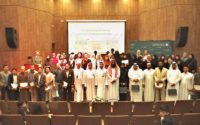UAE Economic Growth To Accelerate In 2018 And 2019
According to ICAEW’s latest report (Economic Insight: Middle East Q2 2018), the UAE economy is set to recover from a difficult year in 2017, when growth slowed to a seven-year low last year at only 1.5%. Overall, UAE’s GDP is expected to accelerate to 2.6% growth in 2018 and to around 3.8% in 2019. But the accountancy and finance body warns that general prices are expected to increase as inflation will rise to 4.0% this year.
Economic Insight: Middle East Q2 2018, produced by Oxford Economics, ICAEW’s partner and economic forecaster, says the UAE’s growth will be primarily driven by recovering oil prices, an expansionary fiscal stance at the federal and emirate levels, a buoyant trade and tourism environment and a pick-up in investment ahead of Expo 2020 in Dubai.
The oil sector contracted by 1.6% last year, mainly because of the OPEC+ mandate that saw the UAE cut its oil production by 150k barrels per day (b/d) from an average of 3.09m b/d in Q4 2016 to an average of 2.89m in Q4 2017, representing a drop of nearly 6.4%. Given the extension of the OPEC agreement to the end of 2018, oil sector growth is expected to be limited this year, especially given the UAE’s increasing compliance with the production cuts, which averaged 124% in the first three months of this year.
The non-oil sector on the other hand proved to be resilient last year despite the unfavourable macroeconomic environment and regional economic slowdown, growing by 3%. The non-oil sector is expected to grow 3.7% in 2018, supported by improving business sentiments, a buoyant trade and tourism environment and higher public spending. Since the UAE is a highly open economy with trade value accounting for more than twice the country’s GDP, any growth in regional and global economic activity will contribute positively to the country’s economic output this year.
The outlook for the UAE’s tourism industry is highly positive. Dubai airport passenger traffic was up 5.5% year over year (y/y) in 2017 and hotel occupancy averaged over 86% in the first two months of this year. The positive trend is likely to continue in 2018.
More positively, the UAE federal government is expected to increase spending by 5.6% y/y. Dubai, which traditionally accounts for 25-30% of the UAE’s GDP, will lift spending by 20% in preparation for Expo 2020, with the allocation for infrastructure alone leaping by 46.5%. The UAE continues to be the top destination in MENA for inward FDI, attracting US$11 bn in 2017.
Michael Armstrong, FCA and ICAEW Regional Director for the Middle East, Africa and South Asia (MEASA), said: “The UAE is on the right track to economic diversification and is implementing the necessary fiscal reforms to support these efforts. The introduction of VAT is an important step toward diversifying government revenue and building tax capacity. We’re also encouraged by the recent announcements to reform business ownership laws and residency visa rules. This will definitely help in attracting more foreign direct investment and in creating more stability in the market.”
When it comes to the real estate sector, prices continued their downward trend in Dubai and Abu Dhabi, reflecting subdued demand, higher supply of housing and a soft job market. Residential sales prices in Dubai fell by 4.7% y/y in March 2018, while Abu Dhabi saw a much sharper 7.2% fall. Nevertheless, the economic upturn and the recent uptick in oil prices are expected to drive some recovery in the real estate sector.
According to the report, general price levels are expected to increase in 2018, as the introduction of VAT is expected to lift inflation to 4.0% this year. Readings of the PMI for the first three months of 2018 show that the tax on goods and services has weighed on the non-oil private sector activity as well, with the PMI index averaging 55.5 in Q1 2018, down from an average of 56.8 in Q4 2017. However, more than half of the firms surveyed in April 2018 by Emirates NBD seemed optimistic about the outlook for the year ahead, stating that they expect higher output in 12-months’ time.
GCC economic growth to pick up despite slow growth in Q1 2018
Middle Eastern economies are also on track to recover from a difficult year in 2017, when growth slowed to an 8-year low at only 1.0%. Overall, the Middle East’s GDP is expected to grow 2.4% in 2018, despite a relatively slow start in the first quarter and a heightened geopolitical environment. However, the outlooks and risk profiles for Middle Eastern economies vary.
According to the report, GCC’s economic prospects are promising this year thanks to rising oil prices, higher government spending and steady progress of economic reform. Overall, the GCC’s GDP is expected to grow 2.3% this year, up from 0.1% last year. And as OPEC increases oil production, GDP growth is expected to accelerate further for oil exporters this year and in 2019.
Mohamed Bardastani, ICAEW Economic Advisor and Senior Economist for Middle East at Oxford Economics, said: “Middle East economies will see pick up in GDP growth this year and in 2019 but this doesn’t mean we should let complacency set in. With growing global trade tensions, geopolitical risks and rising interest rates, economic reforms are more necessary than ever in order to ensure stronger, sustainable and inclusive growth.”









 Email: info@cyber-gear.com
Email: info@cyber-gear.com